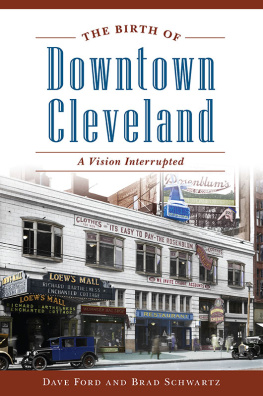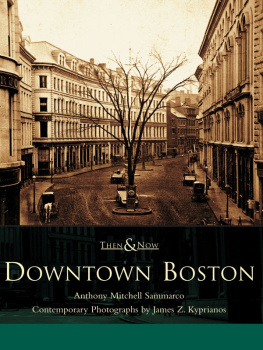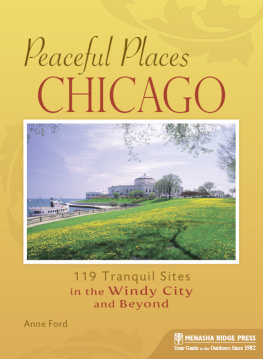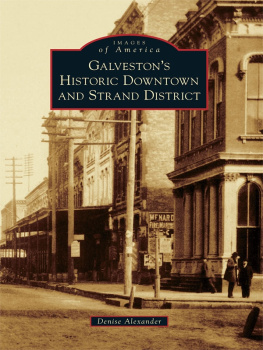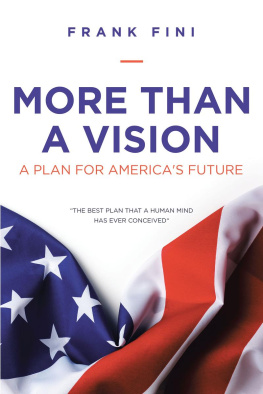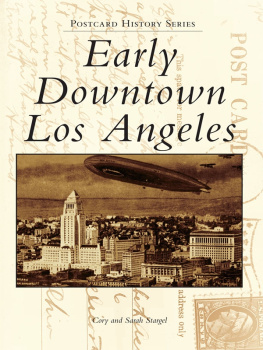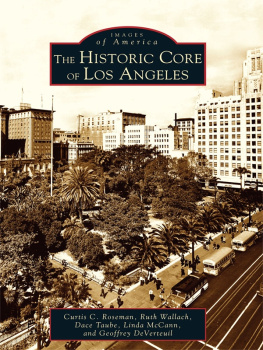
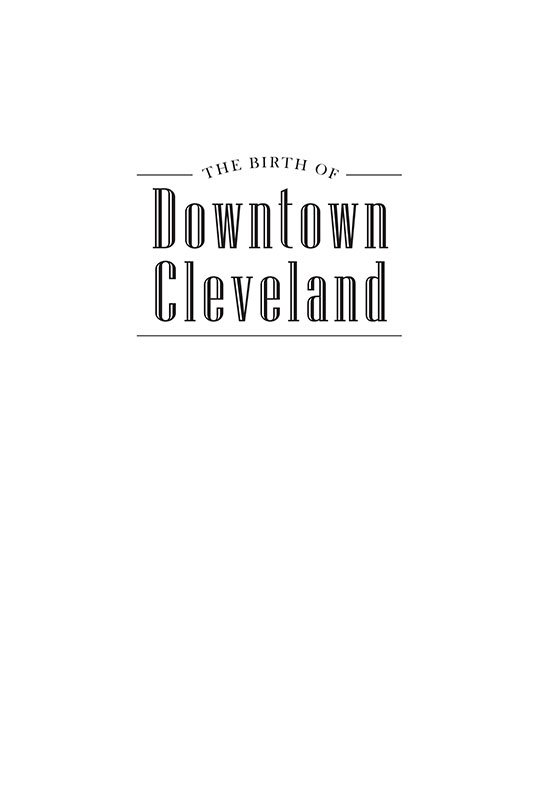

Published by The History Press
Charleston, SC
www.historypress.com
Copyright 2018 by Dave Ford and Brad Schwartz
All rights reserved
First published 2018
e-book edition 2018
ISBN 978.1.439.66472.8
Library of Congress Control Number: 2018936082
print edition ISBN 978.1.467.14015.7
Notice: The information in this book is true and complete to the best of our knowledge. It is offered without guarantee on the part of the authors or The History Press. The authors and The History Press disclaim all liability in connection with the use of this book.
All rights reserved. No part of this book may be reproduced or transmitted in any form whatsoever without prior written permission from the publisher except in the case of brief quotations embodied in critical articles and reviews.
CONTENTS
INTRODUCTION
The focus and vision of Clevelands central core, its downtown, has changed many times since the area along the southern shore of Lake Erie was surveyed and mapped by the Connecticut Land Company in 1796. From its birth as a far outpost of the Connecticut Western reserve, Clevelands downtown has been reborn time and againfrom regional trading center to rail, trucking and air transportation hub and vital industrial manufacturing and economic center. Its current role is as a center for the development of high-tech industries. Even when the visions of its leaders and developers were interrupted by wars and economic and social downturns, Clevelands forward-looking focus has enabled it to continually rebirth and retool itself to meet the needs of the world that surrounds it.
Cleveland, Ohio, became the great city that it is because of its location. Once described as being the Best Location in the Nation, the city is sited at the mouth of a major river that empties into the center of Americas Great Lakes. The Great Lakes are a unique and vital national and world asset, as they serve as a link between a rich, perfectly located United States based manufacturing area and the Atlantic Ocean. Cleveland is located on the shores of Lake Erie, halfway between Buffalo, New York, and Detroit, Michigan, with the cities of Erie, Pennsylvania, and Toledo, Ohio, halfway between Buffalo and Detroit, respectively. The first Paleo-Indians set up seasonal camps in the region that surrounds the Cuyahoga River Valley about twelve thousand years ago, and while they benefited from the vast resources that they found in the area, they were also challenged by the same difficulties that would challenge future occupants of the area for many yearsinherent swampiness and the associated diseases that accompany it.
When the first Caucasian settlers entered the region in 1796, more than ten thousand years after the first Native Americans did so, they came in search of a spot at the western reaches of the Connecticut Western Reservethe eastern shores of the Cuyahoga Riverwhere they could gain a foothold on a claim to an area that would give them access to vast resources before other foreign powers could do the same.
Cleveland has been a city on a seesaw since it was first incorporated as a village in the late 1700s and then as a city in 1836. The city has experienced times of great wealth and growth and times of poverty and decline. The citys location has always been its trump card. At its inception, its location allowed it to function as a conveniently located way station for the shipment of furs and other natural resources. In its heyday, its location allowed it to become one of the countrysand the worldsgreat industrial and manufacturing centers.
Through the years, Clevelands primary challenge might have been that it usually went all-in with the cause du jour. Whether the city was working to become a center for steel manufacturing, chasing a dream of the worlds finest manifestation of a design ethic or capitalizing on a new technology, Cleveland was continually going through cycles of profiting from a change and then failing from its decline.
The Cuyahoga River has literally been a lifeline throughout the citys history. Initially, the river served as a target for its first Caucasian settlers because it marked the western bounds of the Connecticut Western Reserve. As the city developed, the river served as a connection to the Great Lakes and to lands beyond them. Its shores served as a convenient means for loading goods manufactured in the city into lake steamers, as well as a place for offloading raw materials that the city used in its manufacturing processes. In the citys later years, the river would serve as a national bellwether for the environmental problems that accompanied Americas industrial framework. After a series of instances where the toxic sludge that floated on the river caught fire, the river helped to spur the environmental movement in the United States.
Connecticut was one of several states that had land claims in the Ohio Country going back to the colonial period. Connecticut gave up most of its claims to the federal government so that the Northwest Territory could be created. However, it reserved the northeast corner of the territory for itself. This area came to be known as the Connecticut Western Reserve. As one of thirty-six founders of the Connecticut Land Company, General Moses Cleaveland was selected as one of its seven directors and was subsequently sent out as the companys agent to map and survey the companys holdings. In 1796, Cleaveland and his surveyors arrived at the mouth of the Cuyahoga River. General Cleaveland saw the land as an ideal location for the capital city of the Connecticut Western Reserve.
Even in its infancy, until it was able to establish itself as a center for Great Lakes shipping, the city went through periods of financial and population gains and losses. Nothing has shaped Clevelands development more than transportation. Because of its midwestern location, Cleveland was in a prime spot for Great Lakes sail- and steamship-based commerce, an early hub for canal-based transportation and later a hub for eastwest railroad lines. Clevelands transportation network linked it to many of the worlds great commercial centers. Clevelands primary railroad era began in the late 1870s, when the New York Central and Nickel Plate Road built two major rail lines along Lake Eries southern shoreline. This line linked New York with Chicago and St. Louis. The Valley Railway Line was chartered in 1871 to supply Clevelands industrial plant with coal from southeast Ohio and West Virginia. Because of the extensive number of rail lines that transected the city, it needed to construct suitable terminals for the transfer of goods and passengers. Throughout its history, Cleveland would struggle with where to locate its Union Terminal, and that struggle continued to be a controversial topic that would lead to the creation and abandonment of large-scale development projects. Like many American cities, Cleveland swung back and forth politically and experienced both political and social greatness and political and social corruption and downfall.
Clevelands first economic boom came during the Civil War years. Cleveland had become an industrial center by the mid-1800s and was able to manufacture many of the vital military goods that were needed by the Union army. By the end of the Civil War, Cleveland had grown into one of the five main oil refining centers in the United States. This was made possible by its proximity to the oil-rich areas of Western Pennsylvania and by the entrepreneurship of a few of its residents, such as John D. and William Rockefeller. The rise of Clevelands prosperity brought along with it a sudden increase in population, as well as the rise of trade unions that worked to improve working and living conditions and increase workers pay. The establishment of new industries in the late 1800s led to a more than doubling of its population. By the end of the 1870s, Cleveland had grown to a city with a population of more than 160,000.
Next page
